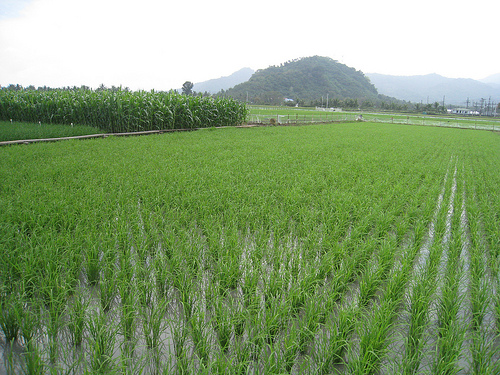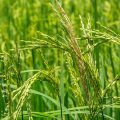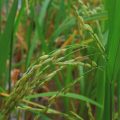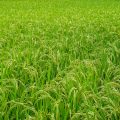A farmers’ group is fast expanding its hybrid rice area to 100 hectares from only 30 hectares after experiencing a yield that gives them a two-cropping’s harvest from a swamp land that only allows once-a-year planting.
Farmers at the marsh land of Cabiao, Nueva Ecija are only able to plant rice during the dry season, traditionally from November to April or May of the following year.

However, in the current dry season harvest, they are harvesting more than 200 cavans per hectare. That is equivalent to two or even three times of harvest from ordinary seeds– even if it is only from one season of planting.
“Our target in our area is immediately to expand hybrid rice to 100 hectares next season,” according to farmer-leader Luisito delos Santos.
He planted the hybrid rice variety SL-18H of SL Agritech Corp. (SLAC) on his 28-hectare rice land this season. Average yield is more than 200 cavans per hectare.
With a high yield, more Filipino farmers earn a net income of P100,000 to P200,000 per hectare.
Most farmers just reap 50 to 80 cavans per hectare using inbred seeds. Harvesting 100 to 120 cavans per hectare from inbreds is already exceptionally good.
Delos Santos’s attractive profit from hybrid seeds since he tried it in year 2000 enabled him to accumulate land for more rice planting. He started with only four hectares then.
By committing to be a hybrid rice winner, he acquired more lands so his area increased to 12 hectares in 2005. By 2010, he had more than 20 hectares.
With his high income now, he just acquired new rice lands so that by himself he will plant SL-
18H on 40 hectares by next cropping.
His brother, Florencio delos Santos and a medical doctor-farmer, Dr. Hubert Lapus, will form part of the group to plant 100 hectares next season. Florencio had a harvest of 280 cavans at 70 kilos per cavan from his planting of SL-18H on 1.8 hectares. Lapus is also medical director of the Paulino J. Garcia Memorial Research and Medical Center.
SL-18H has multiple benefits for farmers planting in a swamp area which is a kind of land found in many places in the Philippines.
There are 34 inland wetlands in the country according to the Society for the Conservation of Inland Wetlands, although not all may be appropriate for rice planting at any given time.
In Cabiao where there is an opportunity to plant rice, using hybrid rice maximizes wealth-creation opportunities.
IN another Nueva Ecija town, in Talavera, Nueva Ecija, farmers belonging to the Nagkakaisang Magsasaka Agricultural Primary MPC (NMAP-MPC) said SL-18H is yielding between 250 to 300 cavans per hectare at 50 kilos per cavan.
“It’s my first time to plant SL-18, and we’re confident of the yield. It gives many stems that are long. The ears of the grain are long. The grains are filled to the tip. If I don’t get at least 250 cavans here, I don’t like to farm anymore (joking),” said Ricardo Buenaventura, NMAP-MPC president.
He planted the hybrid rice on 10 hectares out of his 23 hectares.
Buenaventura is specifically expecting a net income of at least P155,000 even if he just gets 200 cavans.
“At P1,000 per bag (at P20 per kilo) from 200 bags, you get a net of P155,000 since cost is P45,000 to P50,000 per hectare,” he said.
But with 250 cavans, that is an additional P50,000 or a total net earning of P205,000 per hectare which has never been experienced by average Filipino farmers at all. His 10 hectares will give for him P2.050 million!
The high yield from this variety, launched for just one year, is further supplemented by the high price of rice brought about by the Department of Agriculture’s (DA) 2012-2013 rice sufficiency program.
The benefit comes from the Aquino Administration’s position to protect rice farmers from imports.
This time in so many years, many farmers are experiencing improved livelihood due to the high yield along with the high price of paddy rice that currently ranges at P20 to P24 per kilo.
“We’re taking advantage of it since it’s only now that we’re experiencing a good price,” said Buenaventura.
One buyer from Bohol is offering to buy Delos Santos’s palay at a high of P24.50 per kilo.
“They like SL-18 because of good milling quality, good milling recovery,” he said.
Milling recovery for the ordinary rice may reach just 60 to 65 percent.
DA Consultant Santiago R. Obien said SL-18H may have as much milling recovery rate of 67 percent.
Delos Santos has been planting hybrid rice since year 2000 using SL-8H, SLAC’s first hybrid rice variety, or other brands.
“But SL-18 may not be matched by other varieties,” he said. “They do not easily shrivel,” he said.
Santiago dela Cruz, former NMAP-MPC vice chairman, said he expects to harvest more than 200 cavans from SL-18H over the one-hectare land he tills.
“We counted the grains of SL-18, and it’s more than 300 grains per panicle,” said dela Cruz. Other seeds may just give around 200 grains per panicle.
NMAP-MPC itself has grown over the years owing to SLAC’s first hybrid rice variety, SL-8H.
“Before nobody wanted to buy SL-8 even if we’re already assuring farmers we would buy their produce. Now our target is 200,000 bags (of seeds) sold every cropping,” said Buenaventura.
NMAP-MPC is one of the most successful farmers’ group that came about as a result of aggressive hybrid rice program introduced early on during the Arroyo Administration.
It now supplies University of Sto Tomas and its hospital at 2,000 cavans every 15 days.
In order to sustain gains in the hybrid rice sector, farmers are seeking government’s support on a financing or grant program for combine harvester.
A combine harvester boosts farmers’ efficiency. It costs around P1.6 million, and for one that has a flatbed tractor (for transportation), P1.7 million.
With the combine, wastage can only be three percent compared to about 10 percent wastage by combining three processes harvesting, threshing, and winnowing of rice.
Its capacity is to reap rice on one hectare every two hours. With the primitive human labor, harvesting of one hectare may last for a day or two.
“The kabiser (a community leader like a baranggay captain) should have a combine that can be commonly used by farmers. That will help raise our rice production,” said Racquel “Keng” Diamante, SLAC marketing specialist.
When rented, combine fee is 13 cavans per 100 cavans of rice.
Another concern is the high cost of diesel. Delos Santos said he spends a lot for diesel used in pumping water since there is no working national irrigation system.
###
For any questions kindly contact Mr. Luisito delos Santos, 0927-521-8670, Mr. Ricardo Buenaventura, 0918-686-2687; for interview requests, Ms. Analiza C. Mendoza, 0921-338-3816.





